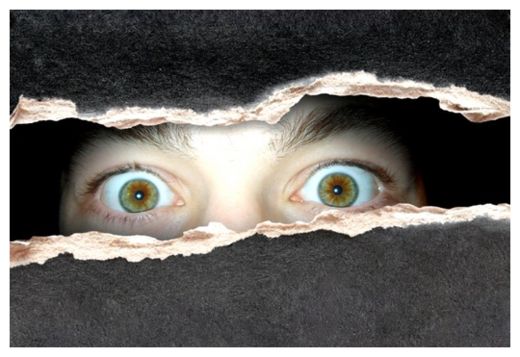
© Lukiyanova Natalia/frenta/Shutterstock
One of the many mind-bending lessons that neuroscience has taught us in recent years is that our brains often 'fudge' the picture of reality that they present us with. For a very simple at-home example, stand in front of a mirror and alternate back and forth between looking at your left eye, then your right eye. No matter how hard you try, you won't be able to see your eyes actually moving.
And it gets even weirder: Not only can you not see your eyes move, but there doesn't appear to be any gap in your perception during the time it takes for your eyes to change their focus from point A (your left eye) to point B (your right eye). One second you're staring at your left eye and the next moment at your left, and that half second in between seems to simply vanish.
What has essentially happened is that your brain has taken a rather complex little scene and 'edited' it in order to present you with a more simplified picture of reality. In essence, your brain is not presenting you with the 'whole truth' but rather with a version of it that is somehow more useful or easier to manage. And modern neuroscience and psychology continue to expose more and more of the human brain's little white lies.
In the results of a recent study published in the journal
Current Biology, two psychologists have shown that a sense of fear and impending danger can actually change our spatial perception of an approaching object.
In general, the human brain is amazingly accurate in its ability to estimate the distance of approaching objects and predict the moment of impact with them. That is, amazingly accurate so long as that approaching object does not appear to pose a threat.
Psychologists
Stella Lourenco of Emory University's
Department of Psychology and
Matthew Longo of Birbeck University of London's
Department of Psychological Sciences teamed up to devise an experiment that would test the effect of fear on a person's ability to accurately predict the moment of impact with approaching objects.
Participants in the study were placed in front of computer screen and shown images of different objects that expanded in size over a period of one second before they disappeared. The images increased in size in order to simulate a phenomenon known as "looming," an optical pattern that the brain uses to predict the amount of time until collision with an approaching object. Study participants were asked so press a button to predict the moment of impact with each of the objects on the screen.
And the experiment had one more twist: Some of the images displayed on the screen were harmless objects such as butterflies or rabbits, while other images were of 'threatening' creatures like snakes and spiders.
The results showed that the individuals consistently underestimated the collision time for threatening images - that is, people who were afraid of snakes or spiders repeatedly believed that they would come into contact with those objects sooner than with non-threatening objects, even when both types of images were "looming" at the same speed.
The team's results call into question the traditional understanding of "looming" as being a mere optical phenomenon that is more or less detached from other brain processes.
"We're showing that what the object is affects how we perceive looming. If we're afraid of something, we perceive it as making contact sooner," explained Longo.
At the crux of the study, Lourenco highlighted, is the idea that perception and emotion may be more entangled in the human mind than we currently understand.
"Fear can alter even basic aspects of how we perceive the world around us," said Lourenco.
What's more, says Lourenco, is that they were able to gauge how much a participant would underestimate the collision time with an object based how afraid they were of it: "The more fearful someone reported feeling of spiders, for example, the more they underestimated time-to-collision for a looming spider."
Viewed from an evolutionary perspective, it's easy to see how this kind of automatic brain response to dangerous objects could have offered a survival advantage to our early ancestors living in the wild. As Lourenco noted: "If an [approaching] object is dangerous, it's better to swerve a half-second too soon than a half-second too late." When a primitive man on the Sahara plains looked up in time to see a lion barreling towards him, it wasn't necessarily a bad thing for his brain to 'trick' him into believing that the approaching danger was a bit more imminent than it really was.
What the researchers do not yet understand is the exact mechanism behind this underestimation of collision time with dangerous objects. For instance, it could be that the fear of a dangerous object causes the brain to perceive the object as moving faster than it actually is. On the other hand, it could also be that a sense of fear causes the threatened individual to experience an enlargement of their personal space, or the sphere in which they feel safe.
"We'd like to distinguish between these two possibilities in future research," says Lourenco. "Doing so will allow us to shed insight on the mechanics of basic aspects of spatial perception and the mechanisms underlying particular phobias."
The team believes that the results of their study will have a number of implications for the research and understanding of clinical phobias.
Reader Comments
to our Newsletter